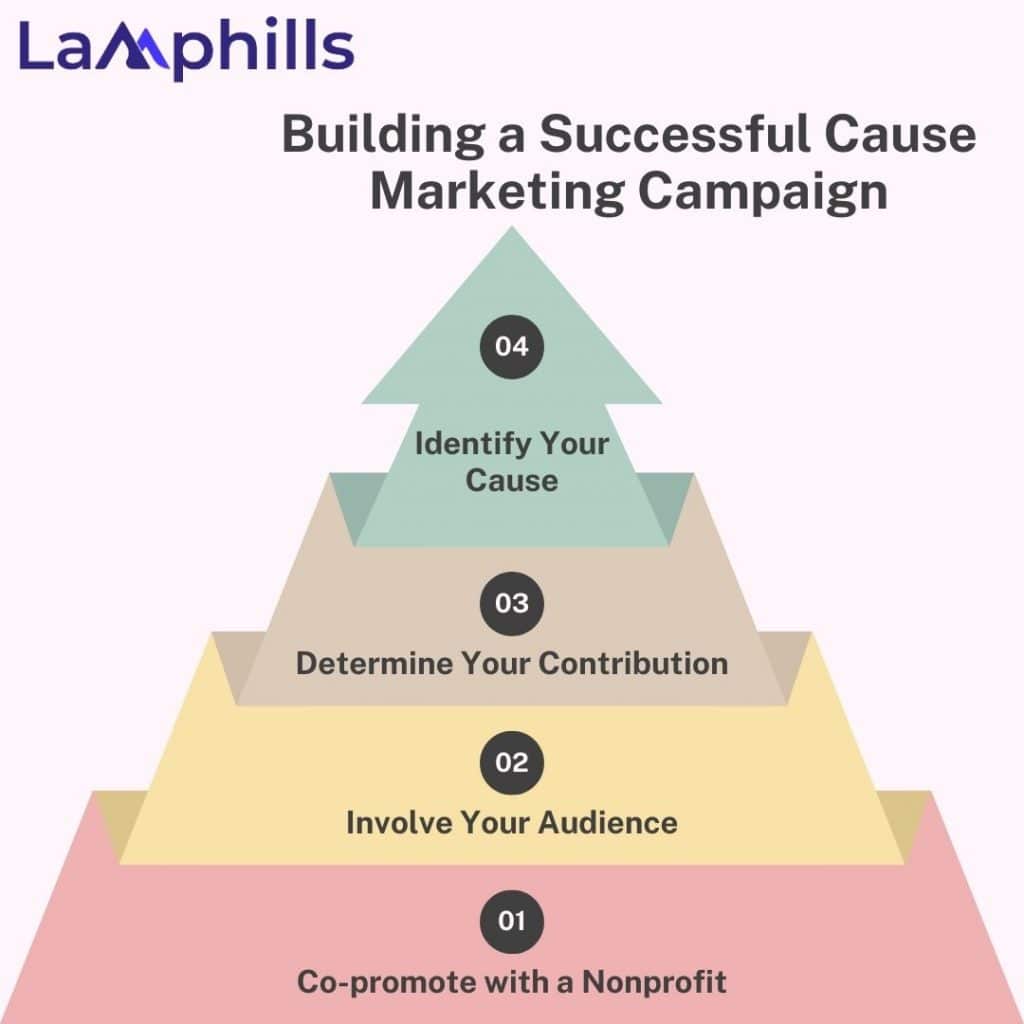I remember when my favourite coffee shop started donating a portion of every sale to a local animal shelter; this is a perfect example of cause marketing. It’s when companies collaborate with social or charitable causes to promote their products while doing good. This strategy helps the cause and makes customers feel good about their purchases. Curious about what causes marketing and looking for examples? Let’s explore successful campaigns and how companies create effective cause marketing strategies.
Key Points
- Cause marketing involves businesses supporting social causes to enhance their profits while benefiting the partnered nonprofit through increased awareness and sometimes proceeds from sales.
- Cause marketing boosts customer loyalty, retention, and brand image by aligning with consumer values related to social and environmental issues.
- Highlighted campaigns include partnerships like The Body Shop’s healthcare worker support and Nike’s collaboration with Colin Kaepernick, showcasing how controversy can sometimes enhance brand image.
- Key strategies include choosing a cause aligned with company values, defining clear goals, involving customers through engagement strategies, and leveraging various marketing channels.
- Cause marketing companies facilitate strategic partnerships between businesses and nonprofits to execute effective campaigns that enhance brand image and drive social impact.
What Is Cause Marketing?
Cause marketing is when a business supports a social cause while boosting its own profits. This often involves a partnership between a company and a nonprofit organization, where the nonprofit gains more awareness. Sometimes, the nonprofit also gets a share of the proceeds from the company’s sales of a specific item or during a certain time. The company benefits by increasing its sales and getting a positive reputation boost.
Why is Cause Marketing Important?

Credit: Freepik
People are increasingly aware of environmental and social issues. In fact, 87% of consumers think more positively about brands that support these initiatives, and 88% say they will be more loyal to such companies. Cause marketing boosts customer loyalty, retention, and awareness of important issues. It’s beneficial for both company revenue and society. This strategy involves collaborations between profit and non-profit organizations to support charities and social causes.
As social consciousness and the need for sustainability grow, brands must adapt. Consumers today highly favor socially responsible companies. Cause marketing allows brands to make a profit while promoting social change. Partnering with non-profits increases awareness and engagement.
Examples of Companies That Adopt The Cause Marketing Strategy
Let’s talk about some well-known examples of cause marketing.
#1. The Body Shop
The Body Shop is all about protecting the environment; you can see it in their “100% Vegan” labels and “Against Animal Testing” messages. They don’t just talk about it; they run campaigns pushing environmental and social responsibility. One of their recent campaigns, “Time To Care,” was a heartfelt thank you to healthcare workers for their hard work. The company donated about 510,000 products to hospitals dealing with COVID-19 to support health and wellness.
#2. Monterey Bay Aquarium
When the Monterey Bay Aquarium had to close due to the pandemic, they faced a financial crisis because there were no visitors to generate income, but the animals still needed care. They launched a YouTube channel about aquatic life to address this, educating viewers and highlighting various animal issues. They also ran the “Act for the Ocean” campaign to raise awareness about climate change, plastic pollution, and ecosystem protection, encouraging people to be more environmentally conscious.
#3. Nike
Nike engages in various impactful initiatives, including rallying athletes during the Coronavirus quarantine to encourage indoor play. This approach promotes their brand and underscores their commitment to promoting health and safety.
One of the most significant is the Nike/Colin Kaepernick collaboration. Kaepernick, a former quarterback for the San Francisco 49ers, faced backlash for taking a knee during the National Anthem to protest the treatment of black people by the U.S. government. After leaving the NFL, he signed with Nike to raise awareness about the black struggle in America.
The campaign sparked even more controversy, with many conservatives burning their Nikes in protest. Surprisingly, Nike benefited from this. People often rebuy products they destroy, and the campaign’s controversy actually boosted Nike’s image and profits, resulting in a $6 billion increase.
#4. Kenneth Cole
Through various initiatives, Kenneth Cole is committed to social justice, equality, and mental health. In December 2023, they launched their inaugural Day of Purpose campaign, marking 40 years of impactful social work. During this event, Kenneth Cole pledged to donate 100% of online sales over 24 hours to support critical mental health efforts.
#5. Coach
Coach emphasizes social impact as a core element of its brand identity. Through initiatives like Coachtopia, a collaborative innovation lab, Coach strives to advance sustainability and support a circular fashion system. As part of their commitment, Coach donates 1% of online sales to Black Girl Environmentalist, a national organization focused on addressing the inclusion and representation of Black girls, women, and gender-expansive individuals in the climate movement.
#6. Veronica Beard
Veronica Beard adopts an ongoing approach to cause marketing, regularly partnering with nonprofit organizations every quarter. From January to March 2023, they collaborated with The Jed Foundation, contributing a portion of their online sales and organizing volunteer events to support mental health initiatives championed by The Jed Foundation.
#7. Dove
Dove has built a strong reputation through marketing campaigns that celebrate real beauty and empower women. Their long-standing efforts focus on promoting positive body image and self-esteem among women of all backgrounds.
#8. Levi Strauss
Levi Strauss has embarked on cause-related marketing initiatives, such as establishing free skateparks for children in India. These efforts demonstrate their commitment to supporting youth and community development through strategic philanthropy.
#9. Savage x Fenty
Rihanna’s Savage x Fenty brand advocates for inclusivity by offering extended sizes across all product lines. This inclusive approach permeates their marketing strategies and product offerings, aiming to empower women of diverse body types and backgrounds.
Cause Marketing Campaign
Cause marketing is super effective and becoming even more important, especially for Millennials and Gen Zs, who respond strongly to campaigns with a cause.
High-purpose brands grow their market value more than four times faster than low-purpose brands (IR Magazine 2020 Corporate Study). Nearly half of consumers (47%) will stop or reduce purchasing from companies that fail to keep their promises on social or environmental issues (Porter Novelli Purpose Priorities Report 2023).
Additionally, 63% of people buy or support brands based on their beliefs and values (2023 Edelman Trust Barometer). It’s also significant that 82% of respondents think companies should show how they follow through on promises to people, the planet, or society (Porter Novelli Purpose Priorities Report 2023). Over half of consumers (51%) believe that the brands they buy from should share their values (5WPR’s 2021 Consumer Culture Report).
To make the most of cause marketing, observe the following tactics:
- Keep your customers informed. Use newsletters and social media to update them on how their spending helps the cause and share specific success stories.
- Launch campaigns that encourage more spending by matching donations for every purchase.
- Include banners about your corporate social responsibility in every email, social media post, and ad campaign.
- Welcome visitors to your social media and website with information about your cause, and remind customers why they should feel good about supporting your company after a purchase.
- Encourage customers to share their involvement in your social cause to build a sense of community and shared purpose.
Examples of Cause Marketing Campaigns
#1. Light the Night
- Who are the partners? Light the Night is an annual fundraising campaign hosted by the Leukemia & Lymphoma Society (LLS) and sponsored by Danaher Corporation.
- Campaign Overview: Danaher Corporation partnered with LLS to create a custom matching gift program for their Giving Tuesday Now campaign. The company encouraged its employees to support the Light the Night fundraising walk, promising to match their contributions dollar-for-dollar. This initiative increased donations and engaged Danaher employees in meaningful ways.
- Why Their Campaign Made the List: This campaign started as a custom matching gift partnership but evolved into a long-term program open to nearly all nonprofit causes. Danaher’s approach highlights how a one-off campaign can grow into a sustainable and impactful effort. Additionally, LLS leverages Double the Donation’s automation platform for a complete matching gift strategy, enhancing its corporate fundraising efforts.
#2. Red Kettle Campaign
- Who are the partners? The Salvation Army Southern Territory partnered with DipJar and local retailers.
- Campaign Overview: The Salvation Army’s Red Kettle holiday staple campaign traditionally collects donations outside stores. Realizing a gap in potential donations from people not carrying cash, they partnered with DipJar to accept credit card donations. Branded DipJars were placed at local coffee shops and retail partners, enabling more people to contribute.
- Why Their Campaign Made the List, This campaign stands out for its innovation in adapting to digital shifts. By addressing the cashless trend, The Salvation Army expanded its donor base. Partner retailers embraced this forward-thinking approach, making the campaign a success. Additionally, online donations and corporate matching gifts through 360MatchPro increased the overall impact.
#3. Red Nose Day
- Who are the partners? Red Nose Day collaborated with Walgreens.
- Campaign Overview Originating in the UK, Red Nose Day has become a significant event in the US. Last year, it raised $49 million by selling over 12 million red noses at Walgreens stores. The six-week campaign encourages customers to buy red noses, take pictures, and participate in fundraising events, with proceeds supporting impoverished children.
- Why Their Campaign Made the List Red Nose Day is successful due to its fun, shareable nature. The campaign’s playful element, combined with the ease of participation, makes it highly engaging. The use of social media to spread awareness and the annual anticipation among donors contribute to its ongoing success.
#4. 100% for the Planet
- Who are the partners? Patagonia organized this campaign with grassroots environmental organizations.
- Campaign Overview On Black Friday, Patagonia pledged to donate 100% of the day’s sales to support environmental organizations. Customers simply had to shop at Patagonia stores, resulting in over $10 million raised. The funds were distributed to underfunded nonprofits working to protect the environment.
- Why Their Campaign Made the List, The simplicity of donating by shopping on Black Friday made this campaign highly effective. Patagonia’s commitment to environmental causes year-round, including donating 1% of all sales and offering employee matching gifts, reinforces their dedication and encourages customer loyalty.
#5. Promotions That Give Back
- Who are the partners?: The American Diabetes Association (ADA) partnered with companies like WeightWatchers, Healthyr, Hilton HHonors, and SurveyMonkey.
- Campaign Overview: The ADA’s Promotions That Give Back campaign involves multiple partnerships, generally following a ‘portion of sales’ model. Each partnership is tailored to align with the ADA’s values, enabling effective collaboration.
- Why Their Campaign Made the List: This campaign excels due to the strong alignment between the ADA and its corporate partners. The overlapping audiences and shared missions enhance the impact of their cause marketing efforts. The ADA also uses Double the Donation’s automation system for efficient matching gift management.
#6. Buy a Pair, Give a Pair
- Who are the partners? Warby Parker partners with healthcare organizations, including VisionSpring.
- Campaign Overview: Warby Parker’s buy-one-give-one model donates a pair of glasses for every pair sold. They also train individuals in developing countries to provide basic eye exams and sell affordable glasses, improving long-term vision care access.
- Why Their Campaign Made the List. This campaign was successful due to its straightforward and impactful model. Warby Parker effectively markets the program and shares beneficiary stories, raising awareness and engaging donors.
#7. PurposeFULL
- Who are the partners? Arby’s partnered with Share Our Strength for the PurposeFULL campaign.
- Campaign Overview Arby’s PurposeFULL campaign, a point-of-sale initiative, raises funds for Share Our Strength by asking customers for donations during transactions. The campaign supports various efforts to combat childhood hunger and food insecurity.
- Why Their Campaign Made the List PurposeFULL’s clear message that $1 can provide up to 10 meals makes it easy for donors to understand their impact. Arby’s ongoing commitment to matching gifts and year-round giving further enhances its corporate social responsibility.
#8. Soar With Reading
- Who are the partners? JetBlue partnered with FirstBook for the Soar With Reading campaign.
- Campaign Overview JetBlue’s Soar With Reading program donates money to provide books for children in low-income neighborhoods and supports schools with diverse reading materials. They also use free book vending machines to promote learning.
- Why Their Campaign Made the List The campaign’s success lies in JetBlue’s comprehensive involvement. Employees are encouraged to volunteer and can request flight vouchers for partner organizations. This hands-on approach strengthens the impact and fosters a culture of giving within the company.
This Checklist for Launching a Cause Marketing Campaign is designed to help you seamlessly integrate your company’s values with a social cause, ensuring your campaign is not only effective but also authentic and resonant with your audience.
Building a Successful Cause Marketing Campaign
A successful cause marketing campaign can bring numerous benefits, such as attracting new leads and fostering customer loyalty and trust. When done right, cause-related marketing can help both your business and your nonprofit partner. For small businesses, cause marketing can build brand awareness that might otherwise be hard to achieve. However, it’s crucial to have a strategic marketing plan before launching your campaign to ensure both parties benefit the most from the collaboration. To build a successful cause marketing campaign, See infographics below:

#1. Identify Your Cause
Your cause marketing campaign should reflect your company’s and customers’ values. While there are examples of successful partnerships between seemingly unrelated organizations, cause marketing feels more genuine when the cause aligns with your brand. Understanding your audience and aligning the campaign with their values will help the nonprofit you support and increase loyalty to your brand. Additionally, your employees are more likely to participate passionately if they believe in the cause, enhancing the outcomes for the nonprofit.
#2. Determine Your Contribution
Monetary donations aren’t the only way to support a cause. Sometimes, money alone isn’t enough to convince consumers and monetary gifts can appear insincere. Moreover, many small businesses may not have the budget for large donations. Fortunately, businesses can offer more than just money. Here are some other ways to contribute:
- Video services for charity events
- Direct mail campaigns
- Email marketing campaigns
- Event planning
- Photography for social media
- Advertising campaign ideas
- Copywriting for print and social media
- Donations of products and services
- Volunteer groups from your company
These contributions can strengthen the association between your products and your nonprofit work. Additionally, monetary support can be funded creatively, such as creating a promotion that donates a portion of sales to a nonprofit.
#3. Involve Your Audience
Your audience can be a powerful force in your cause marketing campaign if you engage them. Use social media or create a custom landing page to encourage participation in various ways:
- Donating to the cause
- Sharing social media posts to spread awareness
- Interacting with your nonprofit partners
- Participating in events
Customer relationship management (CRM) software can help target the right audience and raise awareness for your nonprofit partners. It also ensures you follow up with personalized messages of gratitude, making your audience feel involved and responsible, as 96% of people believe their actions can make a difference. Effective messaging and outreach that validate these feelings can drive engagement.
#4. Co-promote with a Nonprofit
Your campaign will likely gain more traction if both you and your nonprofit partner promote it together:
- Tag each other in social media posts
- Announce your partnership in newsletters
- Send joint press releases to news outlets
- Write blog posts about the experience
- Use each other’s logos in marketing campaigns
Strategizing with your nonprofit partner ensures both of you maximize the partnership’s benefits. Some of the most successful cause marketing campaigns develop omnichannel marketing strategies to boost awareness and exposure. Marketing automation can help strategize by handling repetitive tasks like posting to social media or sending emails.
What is a Cause Marketing Strategy?
A cause marketing strategy is a collaboration where both parties benefit, typically involving a for-profit business and a nonprofit organization. Another way to define it is when a company participates in a charitable or social campaign. Companies often use a marketing plan template as a starting point for their strategy.
The main idea behind a cause marketing strategy is that partnering with a charitable cause can make a business appear more socially conscious and responsible. When done right, it improves the company’s image and can help address past mistakes. However, it’s important to present the effort genuinely, as it can be criticized if it seems like the business is only trying to fix its image.
Creating an Effective Cause Marketing Strategy
The success of your campaign hinges on how well you design it. Here are the steps to develop a compelling campaign that promotes social responsibility:
- Choose the Cause. Start by selecting a cause that aligns with your business. For example, a shoe company might adopt a “buy one, donate one” approach. When the cause is closely related to your company, your team will more effectively develop the strategy.
- Define Your Goals After choosing the cause, outline your objectives. Decide what you want to achieve, such as planting 10,000 trees, donating $100,000 to animal shelters, gaining 1,000 new customers, or increasing brand awareness. Clear goals help you measure the campaign’s success.
- Select the Perfect Timing: Use your resources efficiently by choosing the optimal time for your campaign. Consider factors like corporate schedules, relevant dates, and seasons. Avoid busy periods to ensure you have enough time for development. Decide on the launch date and the campaign’s duration carefully.
- Involve Customers: Engage as many people as possible. Social media is a powerful tool for this. Promote your campaign on platforms like Instagram and Facebook, create a hashtag, and encourage customers to share related content. This will increase their interest and participation.
- Leverage Marketing Channels: Utilize various marketing channels to spread the word. Use social media platforms, email, and messaging apps to inform customers about your campaign. Reaching more people through these channels will encourage broader support.
- Implement a Clear Call-to-Action (CTA): Include a visible CTA in all your messages. Make it easy for customers to support your campaign through donations and by sharing information with others.
With these steps, you can create a robust cause marketing strategy that benefits your business and makes a positive social impact. Let’s see some examples to get inspired.
Examples of Cause Marketing Strategies
Cause marketing can take many forms, depending on your industry, brand, budget, or location. Here are some effective examples:
- Point of Sale: This strategy involves asking customers to donate at the checkout counter or store entrance. Cashiers or campaign representatives might ask if customers would like to contribute to a cause and offer small tokens like candy, stickers, or information about the organization in return. Many successful fundraising campaigns have been executed by simply requesting donations during checkout.
- Triggered Donation: In a triggered donation campaign, a percentage of the purchase price is reserved and donated to a cause. For example, a restaurant might donate a portion of each meal’s price to a chosen cause, with no extra cost to the customer.
- Licensing: This approach raises funds by allowing a company to use a nonprofit’s branding on its products. When a customer buys a branded product, a donation is triggered to the nonprofit. For instance, a credit card company might display a cause’s logo on its cards and donate a percentage of purchases made with that card at certain stores.
- Message Promotion: In this type of campaign, a company dedicates its resources to spreading awareness. The company promotes the cause’s message through advertising, promotional materials, or other attention-getting tactics.
- Employee Engagement: This strategy leverages a company’s employees to volunteer for a social cause. Many companies offer paid days for employees to donate their time and skills to support the cause they are promoting.
Read: What is Exactly Cause-Related Marketing? (+ Practical Examples)
Cause Marketing Company
A cause marketing company specializes in creating strategic partnerships between businesses and nonprofit organizations to achieve mutual benefits. These companies focus on developing campaigns that leverage social responsibility to enhance brand image, engage customers, and drive positive social impact. Here’s an overview of how a cause marketing company operates and its key roles
Marketing companies bridge the gap between corporate entities and nonprofits, facilitating collaborations that align with both parties’ objectives. They strategize, execute, and measure the success of cause-related initiatives, aiming to maximize outcomes for both the business and the cause. These companies play a crucial role in integrating social responsibility into corporate strategies, thereby fostering community engagement and enhancing corporate reputation.
Related Posts
What Is Relationship Marketing? All You Need To Know
Harnessing the Power of ‘Pay to Play’ in Digital Marketing
2024 Digital Marketing Trends: What You Need to Know






